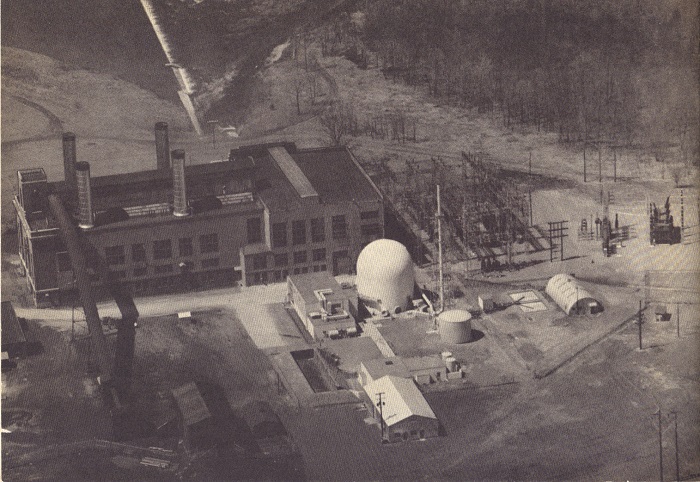Repowering Fossil with Nuclear: Five Fast Facts
 There's talk in some circles these days about selecting fossil-fueled power plants and adding nuclear reactors to them in order to "repower" them without emissions. One early example, the Saxton Experimental Reactor, is seen above in a photo from my collection*. There are some important things to think about before this is tried on a plant; here are five things to consider:
There's talk in some circles these days about selecting fossil-fueled power plants and adding nuclear reactors to them in order to "repower" them without emissions. One early example, the Saxton Experimental Reactor, is seen above in a photo from my collection*. There are some important things to think about before this is tried on a plant; here are five things to consider:
1. Good Fit? Most coal-fired plants today produce steam at very high temperatures and pressures; most nuclear steam supply systems actually do not. The nuclear systems produce much lower temperature and pressure steam, which would make them not necessarily compatible with the generating equipment in the fossil plant which is to be repurposed. Advanced and high-temperature designs are a better theoretical fit, but will take longer to get ready.
2. Where Is It? The siting of nuclear plants is a tricky problem because of the requirement that they not be right near population centers. The much smaller reactors under consideration today help move power generation closer to metro areas, and some are intended to be licensed so that the "Emergency Planning Zone" or EPZ is actually no larger than the plant site's perimeter fence. Whether or not a particular fossil plant can or cannot be repurposed by using nuclear generated steam may in many locales hinge on the siting factor alone.
3. Is The Plant "Bypassed?" In many places these days smaller fossil plants are in the process of being "jumpered out," which is to say that grid assets are being built around them so that the impact of them going away is minimal. If a utility has already spent large amounts of money building grid structure to jumper around a fossil plant, repowering it with nuclear won't make a lot of sense.
4. What Do We Burn? One great "plus" for a nuclear repowering is that it will tend to stabilize fuel cost and stabilize supply. Some utilities and even whole regions are becoming more and more dependent upon a single fuel -- natural gas -- for both electric power generation and residential use (heating, cooking and hot water) which may have a serious supply and price impact later. The old adage that says one shouldn't put all the eggs in one basket applies here, and may be worth considering for the long haul even if at the moment some of the economics don't seem to make sense yet.
5. Who Are Our Partners? Some utility companies are trying to cut down on steady power producers and instead are focusing on renewables, which typically require fast-ramping natural gas plants to bolster their dispatchability issues. A steady-state nuclear plant may not fit in the plans of such an owner; a fast ramping nuclear plant might, if it's available and fits the other important criteria. Grid integration is the name of the game today and hooking on nuclear to existing facilities to decarbonize, as well as stabilize fuel cost and supply may have to be run through this ringer right after siting.
* The Saxton installation was not primarily a power producing installation, although it certainly did feed steam to the original adjacent coal-fired station seen in the photo and that was used for electric power generation. Instead, this facility was mostly intended to carry out testing. Still, the photo gives a good idea of what a real installation from years ago looked like and proves that the concept is not just an idea, but actual reality once. A number of others were built as straight power-producers and some of their stories can be seen here in detail.
 Will Davis is a member of the Board of Directors for the N/S Savannah Association, Inc. He is a consultant to the Global America Business Institute, a contributing author for Fuel Cycle Week, and he writes his own popular blog Atomic Power Review. Davis is also a consultant and writer for the American Nuclear Society, and serves on the ANS Communications Committee and the Book Publishing Committee. He is a former U.S. Navy reactor operator and served on SSBN-641, USS Simon Bolivar.
Will Davis is a member of the Board of Directors for the N/S Savannah Association, Inc. He is a consultant to the Global America Business Institute, a contributing author for Fuel Cycle Week, and he writes his own popular blog Atomic Power Review. Davis is also a consultant and writer for the American Nuclear Society, and serves on the ANS Communications Committee and the Book Publishing Committee. He is a former U.S. Navy reactor operator and served on SSBN-641, USS Simon Bolivar.

